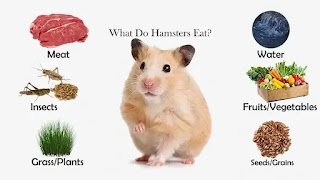Hamsters are small, furry rodents that are popular pets all around the world. They are known for their adorable appearance and playful behavior, which make them great companions for both adults and children alike. However, despite their cuteness, hamsters are also capable of displaying some disturbing behavior, including infanticide.
Infanticide is the killing of offspring, and it is not uncommon among hamsters. In fact, this behavior is so common that it is considered a natural aspect of hamster reproduction. Hamsters eat their young for a variety of reasons, such as to reduce competition for resources or to protect the rest of the litter from harm. While this behavior may be natural, it can be distressing for pet owners, who may not understand why their beloved pet is acting this way.
In this article, we will explore the reasons behind hamster infanticide and how we can prevent and intervene in this behavior. We will look at the causes of infanticide in hamsters, including hormonal changes, lack of resources, and stress and anxiety. We will also examine the role of instincts in hamster infanticide, as well as the ways in which we can prevent and intervene in this behavior.
Overall, this article aims to provide pet owners with a deeper understanding of their hamsters' behavior and to help them create a safe and nurturing environment for their furry friends. By understanding the reasons behind hamster infanticide and taking preventative measures, we can ensure that our hamsters and their offspring are happy and healthy.
Causes of Infanticide in Hamsters
Hamsters are known to engage in infanticide, which is the killing of offspring, and this behavior can be distressing for pet owners. Understanding the reasons behind hamster infanticide can help us prevent and intervene in this behavior. The following are the primary causes of infanticide in hamsters:
1. Lack of Resources
One of the primary reasons hamsters may resort to infanticide is due to a lack of resources. Hamsters are known to have large litters, with some species having up to 20 offspring in a single litter. However, hamsters may not have enough resources, such as food or space, to care for such a large litter. In such cases, the mother may choose to eat some of her offspring in order to reduce the competition for resources and increase the chances of survival for the rest of the litter.
To prevent infanticide due to lack of resources, it is important to provide the mother hamster with sufficient resources during and after pregnancy. This includes providing adequate food, water, and nesting materials. Additionally, it may be necessary to separate the mother from the rest of the litter to ensure that she has enough resources to care for her offspring.
2. Hormonal Changes
Hormonal changes can also contribute to infanticide in hamsters. During pregnancy and lactation, female hamsters experience significant hormonal changes that can affect their behavior. For example, the hormone prolactin, which is responsible for milk production in lactating females, can also increase the mother's aggressive behavior towards her offspring.
To prevent infanticide due to hormonal changes, it may be necessary to intervene with hormonal treatments. For example, giving the mother hamster a dopamine antagonist, such as haloperidol, has been shown to reduce infanticide in some cases. However, it is important to consult with a veterinarian before administering any hormonal treatments, as they can have potentially harmful side effects.
3. Stress and Anxiety
Stress and anxiety can also play a role in hamster infanticide. Hamsters are known to be sensitive to their environment, and stressors such as loud noises, handling, or unfamiliar smells can cause the mother to become anxious and aggressive towards her offspring.
To prevent infanticide due to stress and anxiety, it is important to create a calm and quiet environment for the mother and her offspring. This can include providing a dark and secluded nesting area, minimizing handling of the hamsters, and avoiding sudden loud noises or changes to the environment.
4. Genetic Factors
Genetic factors may also play a role in hamster infanticide. Some hamster strains have been found to be more prone to infanticide than others, suggesting that genetics may play a role in this behavior. Additionally, studies have found that some hamsters may have a genetic predisposition towards cannibalism, which can be passed down from generation to generation.
To prevent infanticide due to genetic factors, it is important to research the hamster strain and breeding history before breeding. Breeders should select hamsters with a lower incidence of infanticide and ensure that they are not breeding closely related hamsters, as this can increase the risk of genetic abnormalities.
5. Maternal Inexperience
Maternal inexperience can also contribute to infanticide in hamsters. First-time mothers may not have the skills or instincts necessary to care for their offspring, which can lead to accidental injury or neglect. In some cases, the mother may resort to infanticide in an attempt to eliminate perceived "weak" or "unhealthy" offspring.
To prevent infanticide due to maternal inexperience, it is important to provide first-time mothers with support and guidance. This can include providing a quiet and secluded nesting area, monitoring the mother and her litter closely, and offering supplemental feeding or care if necessary.
6. Interference from Other Hamsters
Interference from other hamsters can also contribute to infanticide. For example, male hamsters may try to mate with the mother shortly after giving birth, which can result in aggression and infanticide. Additionally, other female hamsters in the same cage may try to harm or kill the offspring.
To prevent infanticide due to interference from other hamsters, it is important to keep hamsters separated by gender and age. Male and female hamsters should only be housed together for breeding purposes, and the mother and her litter should be kept in a separate cage or area away from other hamsters.
By understanding the various causes of hamster infanticide, pet owners and breeders can take steps to prevent this behavior and ensure the health and well-being of their hamsters.
The Role of Instincts
The Instinct to Protect the Mother and Surviving Litter
Despite the disturbing nature of infanticide, it is important to remember that it is a natural behavior for hamsters. In the wild, hamsters face many challenges to their survival, including predation, limited resources, and competition for mates. As a result, hamsters have evolved to be highly adaptable and resilient creatures, with a strong instinct to protect themselves and their offspring.
One of the primary instincts that drives hamster infanticide is the instinct to protect the mother and her surviving litter. By reducing the number of offspring that need to be cared for, the mother can focus her resources on the remaining offspring and increase their chances of survival. In this sense, infanticide can be seen as a survival strategy for the mother and her offspring.
The Instinct to Prioritize Survival over Nurturing
Another instinct that drives hamster infanticide is the instinct to prioritize survival over nurturing. In the wild, hamsters face many challenges to their survival, and they must be able to adapt quickly to changing circumstances in order to survive. This means that hamsters may need to make difficult choices about which offspring to care for and which to abandon.
For example, if a litter of hamsters is born in an area with limited resources, the mother may choose to abandon some of her offspring in order to focus her resources on the strongest and healthiest offspring. While this may seem cruel, it is a natural instinct that allows hamsters to ensure the survival of their offspring in a challenging and unpredictable environment.
While infanticide may seem like a cruel and disturbing behavior, it is important to understand the role that instincts play in this behavior. By recognizing the natural instincts that drive hamster infanticide, we can better understand the behavior and take steps to prevent and intervene when necessary. By providing a safe and nurturing environment for our hamsters, we can ensure that they and their offspring are healthy and happy.
Prevention and Intervention
Providing Enough Resources for the Mother and Litter
One of the primary causes of hamster infanticide is a lack of resources. When a mother hamster does not have access to enough food, water, or nesting material, she may become stressed and anxious, which can lead to infanticide. To prevent this, it is important to provide enough resources for the mother and litter.
Ensure that the mother has access to plenty of food and water, and provide her with nesting material to create a safe and comfortable environment for her and her offspring. It is also important to provide a large enough cage for the mother and litter to move around in comfortably.
Separating the Mother and Litter from External Stressors
External stressors, such as loud noises, bright lights, and other animals, can also trigger hamster infanticide. To prevent this, it is important to keep the mother and litter in a quiet, calm environment away from other animals and bright lights.
If you have other pets in the house, make sure they cannot access the hamster cage, and keep the hamster cage in a room away from loud noises and bright lights.
Use of Hormonal and Behavioral Interventions
In some cases, hormonal and behavioral interventions may be necessary to prevent or intervene in cases of hamster infanticide. For example, a hormone called oxytocin has been shown to reduce infanticide in some rodents, including hamsters. Similarly, providing the mother with a safe and comfortable environment can help reduce stress and anxiety, which can also help prevent infanticide.
If you are concerned about hamster infanticide, it is important to consult with a veterinarian or an experienced hamster breeder for guidance on the best interventions for your specific situation.
👉 Read more posts with the same topic
Conclusion
In this article, we have explored the reasons behind hamster cannibalism and the instincts that drive this behavior. We have discussed the causes of infanticide in hamsters, including a lack of resources, hormonal changes, and stress and anxiety, as well as the role of instincts in this behavior.
We have also discussed strategies for preventing and intervening in cases of hamster infanticide, including providing enough resources for the mother and litter, separating the mother and litter from external stressors, and using hormonal and behavioral interventions when necessary.
Understanding hamster infanticide is important for both hamster breeding and welfare. By recognizing the natural instincts that drive this behavior, we can take steps to prevent and intervene when necessary, and ensure that our hamsters and their offspring are healthy and happy.
By providing a safe and nurturing environment for our hamsters, we can ensure that they have the resources they need to thrive and that we are promoting their overall welfare.









0 Comments